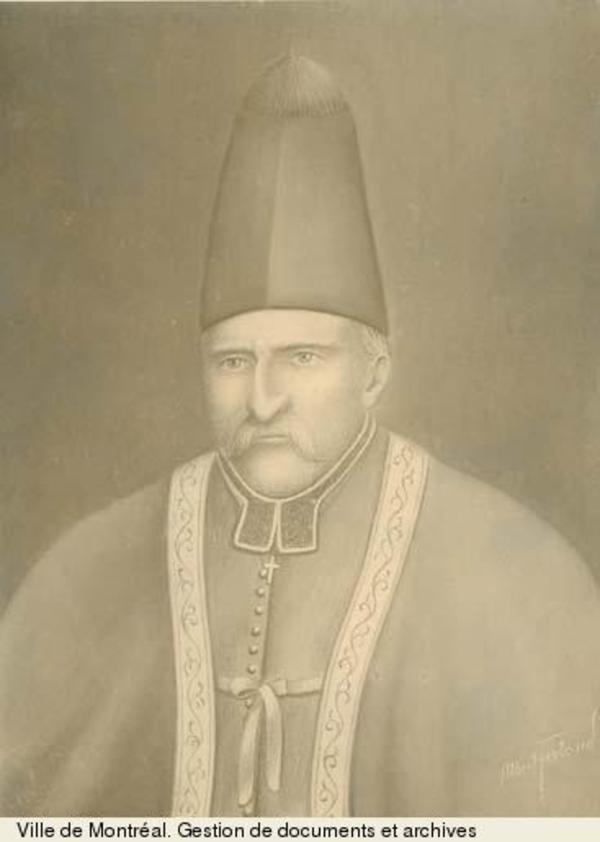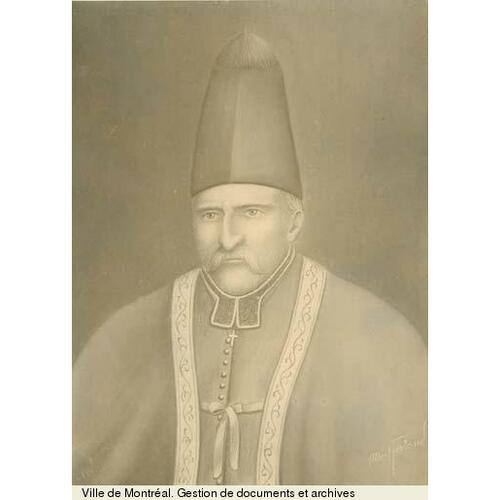
Source: Link
BURKE (Bourke), EDMUND, Roman Catholic priest, vicar apostolic, educator, and author; b. 1753 in Maryborough (Portlaoighise, Republic of Ireland); d. 29 Nov. 1820 in Halifax, N.S.
Educated at the Université de Paris, Edmund Burke was ordained in 1775 or 1776 and for more than a decade did pastoral work in County Kildare (Republic of Ireland). On the advice of the archbishop of Dublin, he left for Quebec in 1786 after having aroused the ill will of influential people through his support for a particular episcopal aspirant. Upon his arrival he was immediately appointed professor of philosophy and mathematics at the Séminaire de Québec. According to a newspaper article published after his death, his lectures at the seminary were thronged by students eager to hear “a man celebrated in the University of Paris, as excelling most men of his day in mathematical science, and also the classics, particularly in the Greek and Hebrew languages.”
Despite his popularity at the seminary, Burke was anxious to become more involved in teaching religion to a larger number of people. Believing that preaching the gospel “is a more rational employment for a priest than giving lectures in astronomy,” he sought and received a pastoral charge: in 1791 he was appointed to the parishes of Saint-Pierre and Saint-Laurent on the Île d’Orléans, and he remained there until 1794. In that year Lieutenant Governor Simcoe of Upper Canada, concerned about the presence of republican agitators in the vicinity of the western posts, appealed to Lord Dorchester [Guy Carleton] for the appointment of a Roman Catholic clergyman to the River Raisin area near Detroit (Mich.). This appeal was relayed to Bishop Hubert*, and as a result Burke was appointed not only missionary to the River Raisin region but also vicar general and superior of the missions of Upper Canada.
Burke, possibly the first English-speaking Roman Catholic priest to work west of Glengarry County, Upper Canada, arrived at Fort Miamis (Maumee City, Ohio) in February 1795, determined “to counteract the Machinations of Jacobin Emissaries . . . amongst the Settlers and numerous Tribes of surrounding Indians.” On the whole, he proved fairly effective in maintaining order. His presence seems to have undercut the attempts of the local inhabitants to have Jean-Antoine Ledru*, a man suspected of republican sympathies, appointed their parish priest. In addition, he tried to assist Simcoe in suppressing the sale of liquor to the Indians, and, “by persevering diligence and at the risque of his life,” he persuaded the settlers to honour their obligation to serve in the militia. Yet, perhaps because of his very success, Burke constantly felt threatened in his new mission. Claiming that in the River Raisin area “you never meet a man, either Indian or Canadian, without his gun in his hand and his knife at his breast,” Burke complained that “brigands” kept him in “continual danger” of his life. To protect himself, he wrote shortly after his arrival, “I have been obliged to keep two Christian Indians well armed, who slept in my room together with a hardy Canadian. I never walked out but in company and always armed.” A couple of years later he asserted that the members of his flock, although baptized in the Roman Catholic Church, were “wicked men given to every vice, but especially to drunkenness and sins against nature. Scarcely can you find a girl of ten years that has not suffered violence.”
When Fort Miamis and Detroit passed under American control in 1796, Burke moved across the border into Upper Canada, becoming chaplain to the military garrison at Fort George (Niagara-on-the-Lake). During the next few years, as vicar general and superior of missions, he helped to lay the foundations of the Roman Catholic faith in Upper Canada by conducting frequent and extensive missionary tours. At the same time he constantly sought assistance from Rome and Quebec in his efforts to increase the number of priests in the colony; unfortunately, he never received the clergy he needed. The low point in his career came in 1801, when an officer at Fort George accused him of attempting to “violate his wife by force.” Burke angrily denied the charge, which indeed seems to have had no basis in fact, and denounced his accuser for spending all his time in the “Grog shop” and consorting with prostitutes.
Burke left Upper Canada in May 1801, when he succeeded his namesake, Edmund Burke, as vicar general of Nova Scotia, still under the jurisdiction of Quebec. He arrived at Halifax in October. As vicar general he attempted to establish a seminary but encountered considerable opposition from Lieutenant Governor Sir John Wentworth and Charles Inglis, the Anglican bishop; eventually the seminary was granted the necessary licence by the provincial government, but it never opened because Burke found it impossible to obtain qualified teachers. Inglis’s hostility to the scheme, as well as his attacks on Roman Catholics and dissenters in his charge of 1803, led Burke to denounce his Anglican opponent in a postscript to his 1804 Letter of instruction to the Catholic missionaries of Nova-Scotia, and its dependencies. Wentworth, in turn, reprimanded Burke for attacking Inglis in an “unreasonable and reprehensible” manner, a criticism that was echoed by Attorney General Richard John Uniacke*. Burke, however, remained unrepentant and as determined as ever to defend the interests of his church. After his assault on Inglis in 1804 he wrote that the Anglican bishop “was completely upset by the dose he received. It is good for him, perhaps it will cure him of his itch for calumniating Catholics, all of whom this bad man would annihilate, if he could.” The following year he replied to criticisms of his Letter of instruction levelled by two prominent Anglican clergymen, William Cochran* and Robert Stanser*, and in 1809 he again revealed his talent for polemics in a debate over the merits of the Roman Catholic faith with the Reverend Thomas McCulloch*, an anti-burgher Presbyterian minister and teacher in Pictou.
In the summer of 1815 Burke crossed the Atlantic, partly for medical reasons and partly to lobby for changes in the ecclesiastical status of Nova Scotia. After a brief visit to Ireland, a country he regarded as the most beautiful and “charming” in the world, he travelled first to London and then to Rome. As a result of reports he submitted to the Vatican, Nova Scotia became a vicariate apostolic – a step which removed it from the jurisdiction of Quebec and placed it directly under the control of Rome. This first division of the diocese of Quebec, perhaps Burke’s greatest contribution to the religious life of Nova Scotia, formally went into effect in July 1817, one year after his return to Halifax. Honoured with the title of bishop of Sion and vicar apostolic of Nova Scotia, Burke was consecrated at Quebec by Bishop Plessis* on 5 July 1818, at the age of 65.
With his new authority Burke had the independence he needed to carry out his work in Nova Scotia. In 1819 he and the Reverend Angus Bernard MacEachern* of Prince Edward Island held discussions on the establishment of a seminary at Arisaig, N.S. This institution did not materialize, but Burke assisted in founding a Trappist monastery near Tracadie [see Jacques Merle*]. Prior to his death in 1820 he had also started a boys’ and girls’ school at Halifax and had ordained five young men to the priesthood. Further, he had recommended the building of a new cathedral, and he laid the cornerstone of this building – St Mary’s Cathedral – on 24 May 1820.
Estimates of Burke’s character vary. In 1794 Bishop Hubert called Burke fickle, but he also described him as “a sociable character, a man of edifying conversation, and above all recommendable for his profound science.” Lord Selkirk [Douglas] was more critical, claiming in late 1804 during a visit to Halifax that “Burke appears to me a man of real genius, acuteness & ability . . . but he seems to be sanguine & far from cool headed, & perhaps in possible combinations of circumstances might be a dangerous enemy.” He also noted that Burke was “reputed bigotted” and was not as popular with his congregation as the Reverend James Jones had been. On the whole, however, it would be a mistake to place too much credence in Selkirk’s statements. Burke seems to have been highly respected in Halifax society and, despite his clashes with a number of churchmen, remained on generally good terms with the members of other denominations. One 19th-century historian wrote that Burke never permitted “differences of opinions to interfere with that kindly and gentlemanly intercourse with his friends for which he was so remarkable.” As a result of his tolerant spirit, the Roman Catholics of Halifax, who numbered approximately 2,000 in 1820, were more easily accepted in the wider community than they had been prior to his arrival.
Edmund Burke is the author of Letter of instruction to the Catholic missionaries of Nova-Scotia, and its dependencies (Halifax, 1804); Remarks on a pamphlet entitled Popery condemned by Scripture and the Fathers (Halifax, 1809); Remarks on the Rev. Mr. Stanser’s examination of the Rev. Mr. Burke’s Letter of instruction to the C.M. of Nova Scotia; together with a reply to the Rev. Mr. Cochran’s fifth and last letter to Mr. B. published in the Nova-Scotia Gazette . . . (Halifax, 1805); A treatise on the first principles of Christianity . . . (2v., Halifax, 1808–10); and A treatise on the ministry of the church . . . (2v. in 1, Dublin, 1817).
PAC, RG 5, A1: 582–97 (mfm. at AO). PANS, Biog., Edmund Burke, docs. (mfm). [John Carroll], The John Carroll papers, ed. T. O’B. Hanley (3v., Notre Dame, Ind., 1976). Corr. of Lieut. Governor Simcoe (Cruikshank), vols.3–5. Douglas, Lord Selkirk’s diary (White). Landmann, Adventures and recollections, 2: 25–27. [Thomas McCulloch], Popery condemned by Scripture and the Fathers: being a refutation of the principal popish doctrines and assertions maintained in the remarks on the Rev. Mr. Stanser’s examination of the Rev. Mr. Burke’s Letter of instruction to the Catholic missionaries of Nova Scotia, and in the reply to the Rev. Mr. Cochran’s fifth and last letter to Mr. Burke . . . (Edinburgh, 1808). Acadian Recorder, 2 Dec. 1820. Caron “Inv. de la corr. de Mgr Denaut,” ANQ Rapport, 1931–32; “Inv. de la corr. de Mgr Hubert et de Mgr Bailly de Messein,” ANQ Rapport, 1930–31; “Inv. de la corr. de Mgr Mariaucheau d’Esgly,” ANQ Rapport, 1930–31; “Inv. de la corr. de Mgr Plessis,” ANQ Rapport, 1927–28; 1928–29; 1932–33. Akins, Hist. of Halifax City, 132, 136, 145, 185–86, 192. [H.-R. Casgrain], Mémoire sur les missions de la Nouvelle-Écosse, du cap Breton et de l’île du Prince-Édouard de 1760 à 1820 . . . réponse aux “Memoirs of Bishop Burke” par Mgr O’Brien . . . (Québec, 1895). Dooner, Catholic pioneers in U. C. Johnston, Hist. of Catholic Church in eastern N.S., vol.1. L. A. Merrigan, “The life and times of Edmund Burke in Nova Scotia, 1801–1820”
Cite This Article
R. A. MacLean, “BURKE (Bourke), EDMUND (1753–1820),” in Dictionary of Canadian Biography, vol. 5, University of Toronto/Université Laval, 2003–, accessed December 28, 2025, https://www.biographi.ca/en/bio/burke_edmund_1753_1820_5E.html.
The citation above shows the format for footnotes and endnotes according to the Chicago manual of style (16th edition). Information to be used in other citation formats:
| Permalink: | https://www.biographi.ca/en/bio/burke_edmund_1753_1820_5E.html |
| Author of Article: | R. A. MacLean |
| Title of Article: | BURKE (Bourke), EDMUND (1753–1820) |
| Publication Name: | Dictionary of Canadian Biography, vol. 5 |
| Publisher: | University of Toronto/Université Laval |
| Year of publication: | 1983 |
| Year of revision: | 1983 |
| Access Date: | December 28, 2025 |



